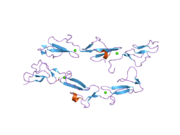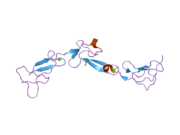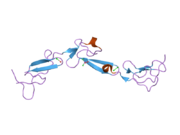EMR2: Difference between revisions
Martstacey (talk | contribs) |
Martstacey (talk | contribs) |
||
| Line 4: | Line 4: | ||
== Structure and function == |
== Structure and function == |
||
This gene encodes a member of the adhesion-GPCR receptor family<ref name="isbn1-4419-7912-3">{{cite book | author = Stacey M, Yona S | title = AdhesionGPCRs: Structure to Function (Advances in Experimental Medicine and Biology) | publisher = Springer | location = Berlin | year = 2011 | pages = | isbn = 1-4419-7912-3 }}</ref> expressed predominantly by cells of the immune system. Family members are characterized by an extended extracellular region with a variable number of [[N-terminal]] protein modules coupled to a [[G protein-coupled receptor|TM7]] region via a domain known as the GPCR-Autoproteolysis INducing |
This gene encodes a member of the adhesion-GPCR receptor family<ref name="isbn1-4419-7912-3">{{cite book | author = Stacey M, Yona S | title = AdhesionGPCRs: Structure to Function (Advances in Experimental Medicine and Biology) | publisher = Springer | location = Berlin | year = 2011 | pages = | isbn = 1-4419-7912-3 }}</ref> expressed predominantly by cells of the immune system. Family members are characterized by an extended extracellular region with a variable number of [[N-terminal]] protein modules coupled to a [[G protein-coupled receptor|TM7]] region via a domain known as the GPCR-Autoproteolysis INducing [[GAIN domain|GAIN)]] domain.<ref name="pmid22333914">{{cite journal | author = Araç D, Boucard AA, Bolliger MF, Nguyen J, Soltis SM, Südhof TC, Brunger AT | title = A novel evolutionarily conserved domain of cell-adhesion GPCRs mediates autoproteolysis | journal = EMBO J. | volume = 31 | issue = 6 | pages = 1364–78 | year = 2012 | month = March | pmid = 22333914 | pmc = 3321182 | doi = 10.1038/emboj.2012.26 }}</ref> In the case of EMR2 the N-terminal domains consist of alternatively spliced epidermal growth factor ([[EGF-like domain|EGF]])-like domains. |
||
This gene is closely linked to the gene encoding egf-like molecule containing mucin-like hormone receptor 3 on chromosome 19 [[EMR3]]. This protein does not interact with the complement regulatory protein, decay accelerating factor |
This gene is closely linked to the gene encoding egf-like molecule containing mucin-like hormone receptor 3 on chromosome 19 [[EMR3]]. This protein does not interact with the complement regulatory protein, decay accelerating factor [[CD55]], unlike the related [[CD97]] antigen, and indicates that these very closely related proteins likely have nonredundant functions. |
||
==See also== |
==See also== |
||
Revision as of 16:21, 2 October 2012
Template:PBB EGF-like module-containing mucin-like hormone receptor-like 2 is a protein that in humans is encoded by the EMR2 gene. EMR2 has also been designated as CD312 (cluster of differentiation 312).
Structure and function
This gene encodes a member of the adhesion-GPCR receptor family[1] expressed predominantly by cells of the immune system. Family members are characterized by an extended extracellular region with a variable number of N-terminal protein modules coupled to a TM7 region via a domain known as the GPCR-Autoproteolysis INducing GAIN) domain.[2] In the case of EMR2 the N-terminal domains consist of alternatively spliced epidermal growth factor (EGF)-like domains.
This gene is closely linked to the gene encoding egf-like molecule containing mucin-like hormone receptor 3 on chromosome 19 EMR3. This protein does not interact with the complement regulatory protein, decay accelerating factor CD55, unlike the related CD97 antigen, and indicates that these very closely related proteins likely have nonredundant functions.
See also
References
- ^ Stacey M, Yona S (2011). AdhesionGPCRs: Structure to Function (Advances in Experimental Medicine and Biology). Berlin: Springer. ISBN 1-4419-7912-3.
- ^ Araç D, Boucard AA, Bolliger MF, Nguyen J, Soltis SM, Südhof TC, Brunger AT (2012). "A novel evolutionarily conserved domain of cell-adhesion GPCRs mediates autoproteolysis". EMBO J. 31 (6): 1364–78. doi:10.1038/emboj.2012.26. PMC 3321182. PMID 22333914.
{{cite journal}}: Unknown parameter|month=ignored (help)CS1 maint: multiple names: authors list (link)
Further reading
- Lin HH, Stacey M, Hamann J; et al. (2000). "Human EMR2, a novel EGF-TM7 molecule on chromosome 19p13.1, is closely related to CD97". Genomics. 67 (2): 188–200. doi:10.1006/geno.2000.6238. PMID 10903844.
{{cite journal}}: Explicit use of et al. in:|author=(help)CS1 maint: multiple names: authors list (link) - Lin HH, Stacey M, Saxby C; et al. (2001). "Molecular analysis of the epidermal growth factor-like short consensus repeat domain-mediated protein-protein interactions: dissection of the CD97-CD55 complex". J. Biol. Chem. 276 (26): 24160–9. doi:10.1074/jbc.M101770200. PMID 11297558.
{{cite journal}}: Explicit use of et al. in:|author=(help)CS1 maint: multiple names: authors list (link) CS1 maint: unflagged free DOI (link) - Kwakkenbos MJ, Chang GW, Lin HH; et al. (2002). "The human EGF-TM7 family member EMR2 is a heterodimeric receptor expressed on myeloid cells". J. Leukoc. Biol. 71 (5): 854–62. PMID 11994511.
{{cite journal}}: Explicit use of et al. in:|author=(help)CS1 maint: multiple names: authors list (link) - Stacey M, Chang GW, Davies JQ; et al. (2003). "The epidermal growth factor-like domains of the human EMR2 receptor mediate cell attachment through chondroitin sulfate glycosaminoglycans". Blood. 102 (8): 2916–24. doi:10.1182/blood-2002-11-3540. PMID 12829604.
{{cite journal}}: Explicit use of et al. in:|author=(help)CS1 maint: multiple names: authors list (link) - Chang GW, Stacey M, Kwakkenbos MJ; et al. (2003). "Proteolytic cleavage of the EMR2 receptor requires both the extracellular stalk and the GPS motif". FEBS Lett. 547 (1–3): 145–50. doi:10.1016/S0014-5793(03)00695-1. PMID 12860403.
{{cite journal}}: Explicit use of et al. in:|author=(help)CS1 maint: multiple names: authors list (link) - Grimwood J, Gordon LA, Olsen A; et al. (2004). "The DNA sequence and biology of human chromosome 19". Nature. 428 (6982): 529–35. doi:10.1038/nature02399. PMID 15057824.
{{cite journal}}: Explicit use of et al. in:|author=(help)CS1 maint: multiple names: authors list (link) - Lin HH, Chang GW, Davies JQ; et al. (2004). "Autocatalytic cleavage of the EMR2 receptor occurs at a conserved G protein-coupled receptor proteolytic site motif". J. Biol. Chem. 279 (30): 31823–32. doi:10.1074/jbc.M402974200. PMID 15150276.
{{cite journal}}: Explicit use of et al. in:|author=(help)CS1 maint: multiple names: authors list (link) CS1 maint: unflagged free DOI (link) - Bjarnadóttir TK, Fredriksson R, Höglund PJ; et al. (2005). "The human and mouse repertoire of the adhesion family of G-protein-coupled receptors". Genomics. 84 (1): 23–33. doi:10.1016/j.ygeno.2003.12.004. PMID 15203201.
{{cite journal}}: Explicit use of et al. in:|author=(help)CS1 maint: multiple names: authors list (link) - Chang GW, Davies JQ, Stacey M; et al. (2007). "CD312, the human adhesion-GPCR EMR2, is differentially expressed during differentiation, maturation, and activation of myeloid cells". Biochem. Biophys. Res. Commun. 353 (1): 133–8. doi:10.1016/j.bbrc.2006.11.148. PMID 17174274.
{{cite journal}}: Explicit use of et al. in:|author=(help)CS1 maint: multiple names: authors list (link)
This article incorporates text from the United States National Library of Medicine, which is in the public domain.



